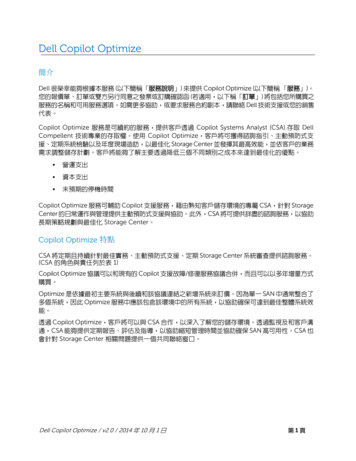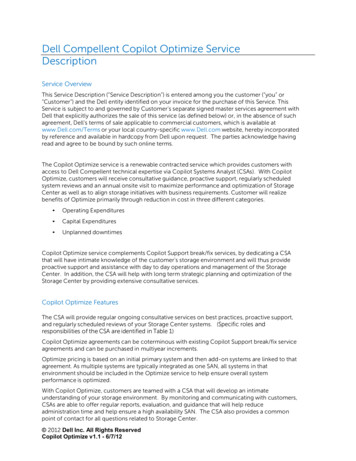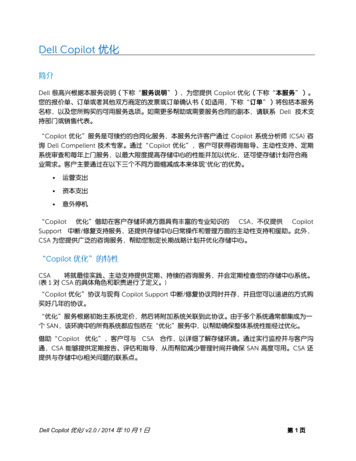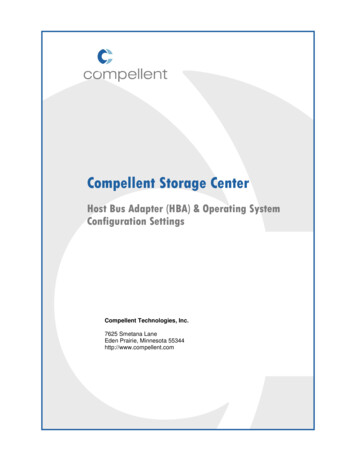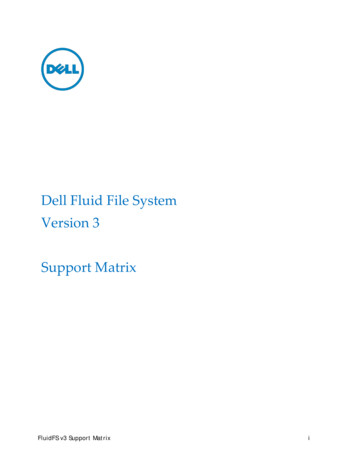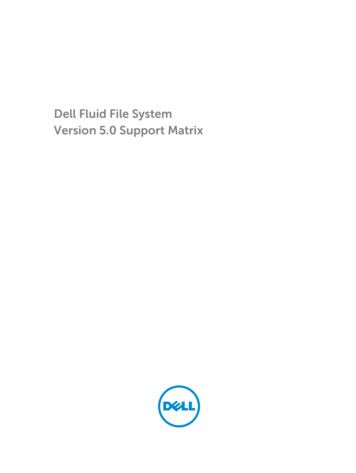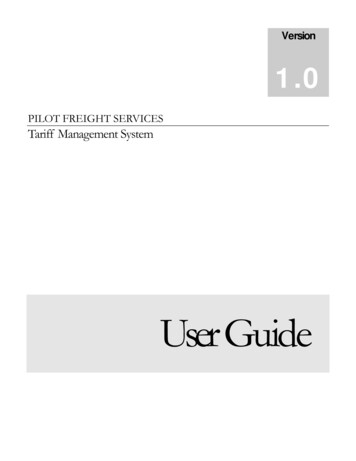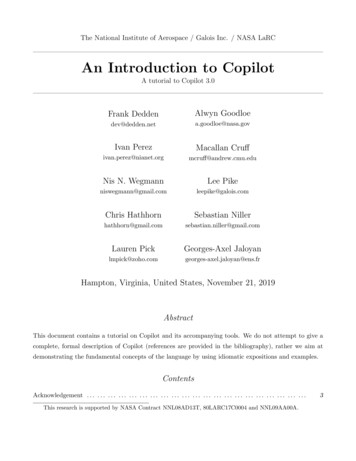
Transcription
The National Institute of Aerospace / Galois Inc. / NASA LaRCAn Introduction to CopilotA tutorial to Copilot 3.0Frank DeddenAlwyn Goodloedev@dedden.neta.goodloe@nasa.govIvan PerezMacallan Cruffivan.perez@nianet.orgmcruff@andrew.cmu.eduNis N. WegmannLee Pikeniswegmann@gmail.comleepike@galois.comChris HathhornSebastian Lauren PickGeorges-Axel ampton, Virginia, United States, November 21, 2019AbstractThis document contains a tutorial on Copilot and its accompanying tools. We do not attempt to give acomplete, formal description of Copilot (references are provided in the bibliography), rather we aim atdemonstrating the fundamental concepts of the language by using idiomatic expositions and examples.ContentsAcknowledgement . . . . . . . . . . . . . . . . . . . . . . . . . . . . . . . . . . . . . . . . . . . . . . . . . . . . . . . . . . . . . . .This research is supported by NASA Contract NNL08AD13T, 80LARC17C0004 and NNL09AA00A.3
123Introduction. . . . . . . . . . . . . . . . . . . . .31.1Target Application Domain . . . . . . . . . . . . . . . . . . . . . . . . . . . . . . . . . . . . . . . . . . . . . . . .31.2Installation. . . . . . . . . . . . . . . . . . . .41.3Structure . . . . . . . . . . . . . . . . . . . . . . . . . . . . . . . . . . . . . . . . . . . . . . . . . . . . . . . . . . . . . . .51.4Sampling . . . . . . . . . . . . . . . . . . . . . . . . . . . . . . . . . . . . . . . . . . . . . . . . . . . . . . . . . . . . . . .5Interpreting and Compiling. . . . . . . . . . . . . . . . .72.1Interpreting Copilot . . . . . . . . . . . . . . . . . . . . . . . . . . . . . . . . . . . . . . . . . . . . . . . . . . . . . .72.2Compiling Copilot. . . . . . . . . . . . . . . . . .8. . . . . . . . . . . . . . . . . . . . . .8Language3.1Streams as Lazy-Lists. . . . . . . . . . . . . . . . .103.2Structs. . . . . . . . . . . . . . . . . . . . .113.3Functions on Streams3.4Stateful Functions3.5Types3.6Interacting With the Target Program. . . . . . . . . . . . . . . . .14. . . . . . . . . . . . . . . . . .14. . . . . . . . . . . . . . . . . . . . .15. . . . . . . . . . . . .16Complete example . . . . . . . . . . . . . . . . . . . . . . . . . . . . . . . . . . . . . . . . . . . . . . . . . . . . . . . . . . . .194.1C Code. . . . . . . . . . . . . . . . . . . . .194.2Specification . . . . . . . . . . . . . . . . . . . . . . . . . . . . . . . . . . . . . . . . . . . . . . . . . . . . . . . . . . . .214.3Generating C code. . . . . . . . . . . . . . . . . .22References . . . . . . . . . . . . . . . . . . . . . . . . . . . . . . . . . . . . . . . . . . . . . . . . . . . . . . . . . . . . . . . . . . . . .2242
AcknowledgementThe authors are grateful for NASA Contract NNL08AD13T to Galois Inc. and the NationalInstitute of Aerospace, which partially supported this work. Thanks to Lars Kuhtz, BenedettoDi Vito, Robin Morisset, Kaveh Darafsheh.1IntroductionNeither formal verification nor testing can ensure system reliability. Over 25 years ago, Butlerand Finelli showed that testing alone cannot verify the reliability of ultra-critical software [BF93].Runtime verification (RV) [GP10], where monitors detect and respond to property violations atruntime, has the potential to enable the safe operation of safety-critical systems that are too complex to formally verify or fully test. Technically speaking, a RV monitor takes a logical specificationφ and execution trace τ of state information of the system under observation (SUO) and decideswhether τ satisfies φ. The Simplex Architecture [Sha01] provides a model architectural pattern forRV, where a monitor checks that the executing SUO satisfies a specification and, if the property isviolated, the RV system will switch control to a more conservative component that can be assuredusing conventional means that steers the system into a safe state. High-assurance RV provides anassured level of safety even when the SUO itself cannot be verified by conventional means.Copilot is a RV framework for specifying and generating monitors for C programs that isembedded into the functional programming language Haskell [Jon02]. A working knowledge ofHaskell is necessary to use Copilot effectively; a variety of books and free web resources introduceHaskell. Copilot uses Haskell language extensions specific to the Glasgow Haskell Compiler (GHC).1.1Target Application DomainCopilot is a domain-specific language tailored to programming runtime monitors for hard real-time,distributed, reactive systems. Briefly, a runtime monitor is program that runs concurrently with atarget program with the sole purpose of assuring that the target program behaves in accordancewith a pre-established specification. Copilot is a language for writing such specifications.A reactive system is a system that responds continuously to its environment. All data to andfrom a reactive system are communicated progressively during execution. Reactive systems differfrom transformational systems which transform data in a single pass and then terminate, as forexample compilers and numerical computation software.A hard real-time system is a system that has a statically bounded execution time and memoryusage. Typically, hard real-time systems are used in mission-critical software, such as avionics,medical equipment, and nuclear power plants; hence, occasional dropouts in the response time orcrashes are not tolerated.3
A distributed system is a system which is layered out on multiple pieces of hardware. Thedistributed systems we consider are all synchronized, i.e., all components agree on a shared globalclock.1.2InstallationBefore downloading the copilot source code, you must first install an up-to-date version of GHC(the minimal required version is 8.0). The easiest way to do this is to download and install theHaskell Platform, which is freely distributed from here:http://hackage.haskell.org/platformBecause Copilot compiles to C code, you must also install a C compiler such as GCC (https://gcc.gnu.org/install/). After having installed the Haskell Platform and C compiler, Copilotcan be downloaded and installed in the following two ways: Hackage (Prefered Method): Copilot is available from Hackage, and the latest versioncan be installed easily:cabal install copilot From source: Alternatively one can download and install it from the repositories as well.Typically one would only go this route to develop Copilot. For regular users the hackagemethod above is highly recommended.git clone https://github.com/Copilot-Language/copilot.gitcd copilotgit submodule update --init --remoteCompiling can either be done in a Nix-style build, or a traditional one:Nix-Style build (Cabal 2.x):cabal buildcabal v2-build# For Cabal 3.x# For Cabal 2.xTraditional build (Cabal 1.x):cabal install --dependencies-onlycabal buildTo use the language, your Haskell module should contain the following import:import Language.CopilotTo use the C99 back-end, import it:4
import Copilot.Compile.C99If you need to use functions defined in the Prelude that are redefined by Copilot (e.g., arithmeticoperators), import the Prelude qualified:import qualified Prelude as P1.3StructureCopilot is distributed through a series of packages at Hackage: copilot-language: Contains the language front-end. copilot-theorem: Contains extensions to the language for proving properties about Copilotprograms using various SMT solvers and model checkers. copilot-core: Contains an intermediate representation for Copilot programs. copilot-c99: A back-end for Copilot targeting C99. copilot-libraries: A set of utility functions for Copilot, including a clock-library, a lineartemporal logic framework, a voting library, and a regular expression framework.Many of the examples in this paper can be found at aster/Examples.1.4SamplingThe idea of sampling representative data from a large set of data is well established in data scienceand engineering. For instance, in digital signal processing, a signal such as music is sampled at ahigh enough rate to obtain enough discrete points to represent the physical sound wave. The fidelityof the recording is dependant on the sampling rate. Sampling a state variable of an executingprogram is similar, but variables are rarely continuous signals so they lack the nice propertiesof continuity. Monitoring based on sampling state-variables has historically been disregarded asa runtime monitoring approach, for good reason: without the assumption of synchrony betweenthe monitor and observed software, monitoring via sampling may lead to false positives and falsenegatives [DDE08]. For example, consider the property (0; 1; 1) , written as a regular expression,denoting the sequence of values a monitored variable may take. If the monitor samples the variableat the inappropriate time, then both false negatives (the monitor erroneously rejects the sequenceof values) and false positives (the monitor erroneously accepts the sequence) are possible. Forexample, if the actual sequence of values is 0, 1, 1, 0, 1, 1, then an observation of 0, 1, 1, 1, 1 is afalse negative by skipping a value, and if the actual sequence is 0, 1, 0, 1, 1, then an observation of0, 1, 1, 0, 1, 1 is a false positive by sampling a value twice.5
However, in a hard real-time context, sampling is a suitable strategy. Often, the purpose ofreal-time programs is to deliver output signals at a predicable rate and properties of interest aregenerally data-flow oriented. In this context, and under the assumption that the monitor andthe observed program share a global clock and a static periodic schedule, while false positives arepossible, false negatives are not. A false positive is possible, for example, if the program does notexecute according to its schedule but just happens to have the expected values when sampled. Ifa monitor samples an unacceptable sequence of values, then either the program is in error, themonitor is in error, or they are not synchronized, all of which are faults to be reported.Most of the popular runtime monitoring frameworks inline monitors in the observed programto avoid the aforementioned problems with sampling. However, inlining monitors changes the realtime behavior of the observed program, perhaps in unpredicable ways. Solutions that introducesuch unpredictability are not a viable solution for ultra-critical hard real-time systems. In asampling-based approach, the monitor can be integrated as a separate scheduled process duringavailable time slices (this is made possible by generating efficient constant-time monitors). Indeed,sampling-based monitors may even be scheduled on a separate processor (albeit doing so requiresadditional synchronization mechanisms), ensuring time and space partitioning from the observedprograms. Such an architecture may even be necessary if the monitored program is physicallydistributed.When deciding whether to use Copilot to monitor systems that are not hard real-time, the usermust determine if sampling is suitable to capture the errors and faults of interest in the SUO. Inmany cyber-physical systems, the trace being monitored is coming from sensors measuring physicaldata such as GPS coordinates, air speed, and actuation signals. These continuous signals do notchange abruptly so as long as it is sampled at a suitable rate, that usually must be determinedexperimentally, sampling is sufficient.6
2Interpreting and CompilingThe Copilot RV framework comes with both an interpreter and a compiler.2.1Interpreting CopilotAssume we are currently in a directory containing a .hs file with our specification (Spec.hs inthis case), and that Copilot is installed globally. If we want to interpret the specification, we needto start the GHC Interpreter with the file as an argument: ghci Spec.hsGHCi, version 8.4.3: http://www.haskell.org/ghc/ :? for helpLoaded GHCi configuration from /home/user/.ghc/ghci.conf[1 of 1] Compiling Spec( Spec.hs, interpreted )Ok, one module loaded.*Spec This launches ghci, the Haskell interpreter, with Spec.hs loaded. It provides us with a prompt,recognisable by the sign. Lets assume that our file contains one specification, called spec. Wecan interpret this using the interpret-function: Spec interpret 10 specThe first argument to the function interpret is the number of iterations that we want to evaluate.The second argument is the specification (of type Spec) that we wish to interpret.The interpreter outputs the values of the arguments passed to the trigger, if its guard is true,and -- otherwise. We will discuss triggers in more detail later, but for now, just know that theyproduce an output only when the guard function is true. For example, consider the followingCopilot program:spec dotrigger "trigger1" (even nats) [arg nats, arg odd nats]trigger "trigger2" (odd nats) [arg nats]where nats is the stream of natural numbers, and even and odd are the guard functions that takea stream and return whether the point-wise values are even or odd, respectively. The lists at theend of the trigger represent the values the trigger will output when the guard is true. The outputofinterpret 10 specis as follows:trigger1:(0,false)--trigger2:-(1)7
(7)-(9)Note that trigger1 outputs both the number and whether that number is odd, while trigger2only outputs the number. This output reflects the arguments passed to them.2.2Compiling CopilotCompiling a Copilot specification is straightforward. Currently Copilot supports one back-end,copilot-c99 that creates constant-space C99 code. Using the back-end is rather easy, as it justrequires one to import it in their Copilot specification file:import Copilot.Compile.C99Importing the back-end provides us with the compile-function, which takes a prefix as its firstparameter and a reified specification as its second. When inside ghci, with our file loaded, we cangenerate output code by executing: 1reify spec compile "monitor"This generates two output files: prefix .c: C99 file containing the generated code and the step() function. This shouldbe compiled by the C compiler, and included in the final binary. prefix .h: Header providing the public interface to the monitor. This file should beincluded from your main project.Please refer to the complete example 4 for more on detail to use the monitor in your C program.3LanguageCopilot is embedded into the functional programming language Haskell [Jon02], and a workingknowledge of Haskell is necessary to use Copilot effectively. Copilot is a pure declarative language;i.e., expressions are free of side-effects and are referentially transparent. A program written in1Two explanations are in order: (1) reify allows sharing in the expressions to be compiled [Gil09], and isa higher-order operator that takes the result of reification and “feeds” it to the compile function.8
Copilot, which from now on will be referred to as a specification, has a cyclic behavior, where eachcycle consists of a fixed series of steps: Sample external variables and arrays. Update internal variables. Fire external triggers. (In case the specification is violated.) Update observers (for debugging purpose).We refer to a single cycle as an iteration or a step.All transformation of data in Copilot is propagated through streams. A stream is an infinite,ordered sequence of values which must conform to the same type. E.g., we have the stream ofFibonacci numbers:sf ib {0, 1, 1, 2, 3, 5, 8, 13, 21, . . . }We denote the nth value of the stream s as s(n), and the first value in a sequence s as s(0). Forexample, for sf ib we have that sf ib (0) 0, sf ib (1) 1, sf ib (2) 1, and so forth.Constants as well as arithmetic, boolean, and relational operators are lifted to work pointwiseon streams:x :: Stream Int32x 5 5y :: Stream Int32y x xz :: Stream Boolz x 10 && y 200Here the streams x, y, and z are simply constant streams:x{10, 10, 10, . . . }, y{100, 100, 100, . . . }, z{T, T, T, . . . }Two types of temporal operators are provided, one for delaying streams and one for lookinginto the future of streams:( ) :: [a] - Stream a - Stream adrop :: Int - Stream a - Stream aHere xs s prepends the list xs at the front of the stream s. For example the stream w definedas follows, given our previous definition of x:w [5,6,7] x9
evaluates to the sequence w{5, 6, 7, 10, 10, 10, . . . }. The expression drop k s skips the first kvalues of the stream s, returning the remainder of the stream. For example we can skip the firsttwo values of w:u drop 2 wwhich yields the sequence u{7, 10, 10, 10, . . . }.3.1Streams as Lazy-ListsA key design choice in Copilot is that streams should mimic lazy lists. In Haskell, the lazy-list ofnatural numbers can be programmed like this:nats ll :: [Int32]nats ll [0] zipWith ( ) (repeat 1) nats llAs both constants and arithmetic operators are lifted to work pointwise on streams in Copilot,there is no need for zipWith and repeat when specifying the stream of natural numbers:nats :: Stream Int32nats [0] (1 nats)In the same manner, the lazy-list of Fibonacci numbers can be specified in Haskell as follows:fib ll :: [Int32]fib ll [1, 1] zipWith ( ) fib ll (drop 1 fib ll)In Copilot we simply throw away zipWith:fib :: Stream Int32fib [1, 1] (fib drop 1 fib)Copilot specifications must be causal, informally meaning that stream values cannot dependon future values. For example, the following stream definition is allowed:f :: Stream Word64f [0,1,2] fg :: Stream Word64g drop 2 fBut if instead g is defined as g drop 4 f, then the definition is disallowed. While ananalogous stream is definable in a lazy language, we bar it in Copilot, since it requires futurevalues of f to be generated before producing values for g. This is not possible since Copilotprograms may take inputs in real-time from the environment (see Section 3.6).10
3.2StructsStructs require some special attentation in Copilot, as we cannot magically import the definitionof the struct in Copilot. In this section we discuss the steps that need to be taken by following thecode of Struct.hs in the Examples directory of the Copilot distribution, or the repository 2 .Let’s assume that we have defined a 2d-vector type in our C code:struct vec {float x;float y;};For us to be able to use this vector inside Copilot, we need to follow a number of steps:1. Enable DataKinds compiler extension.2. Define a datatype to mimic the C definition.3. Write an instance of the Struct class, containing a definition for the struct name and functionto translate the fields to a heterogeneous list.4. Write an instance of the Typed class.Enabling compiler extensionsFirst and foremost, we need to enable the DataKinds extension to GHC, by putting:{ # LANGUAGE DataKinds # }at the top of our specification file. This allows us to define kinds, which are the types of types.Our datatype needs to carry the names of the fields in C as well. Using the DataKinds extensionwe are able to write the names of the fields as part of our types.Defining the datatypeA suitable representation of structs in Haskell is provided by the record-syntax, this allows us touse named fields as part of the datatype. For Copilot this is not enough though: we still need todefine the names of the fields in our C code. Therefore we introduce new Field datatype, whichtakes two arguments: the name of field, and it’s type. Now we can mimic our vector struct inCopilot as follows:data Vec Vec{ x :: Field "x" Float, y :: Field "y" /blob/master/Examples/Struct.hs11
Here we created two fields, x and y, each with their corresponding C names and types. Notethat the name inside Haskell and the C names do not necessarily need to match, nor is it alwayspossible to have them match. For type-safety, inside Copilot we will typically only use the Haskelllevel names (i.e. the unquoted ones). The C names are only used by Copilot internally.Instance of StructOur next task is to inform Copilot about our new type, therefore we need to write and instance ofthe Struct-class. This class has the purpose of defining the datatype as a struct, it provides thecode generator of Copilot the name of struct in C, and provides a function to translate the structto a list of values:instance Struct Vec where typename : : Vec Stringtypename "vec" Name of the type in C Function to tovalues : :toValues v [,]translate Vec to l i s t of Value ’ s , order should match struct .Vec [ Value Vec]Value Float (x v)Value Float (y v)Both definitions should be pretty self-explanatory. Note however that Value a is a wrapper aroundthe Field datatype to hide the actual type of Field. It takes the type of the field, and the fielditself as its arguments. The elements in the list should be in the same order as the fields in thestruct.Both typename and toValues have to be defined by the user, but neither should ever be usedby the user. Both functions are only used by the code generator of Copilot.Instance of TypedIn Copilot, streams can only of types that are instances of the Typed class. To be able to createstreams of vectors, Vec needs to be an instance of Typed as well. The class only provides a typeOffunction, returning the type:instance Typed Vec wheretypeOf Struct (Vec (Field 0) (Field 0))For Vec this means we need to return something of the Vec type wrapped in the Struct constructor.In this case it does not matter what the values of the fields are, we just need to return somethingof the correct type.12
Simple operationsBuilding streams of structs works like building any other stream, but we need to wrap the valuesof a struct using the Field constructor. The reason for this is quite straightforward: the fields ofour struct are defined in terms of Field:v :: Stream Vecv [ Vec (Field 0) (Field 1) ] vWe can also turn a field of a struct into its own stream using the (#)-operator:vx :: Stream Floatvx v # xNote the we use the Haskell level accessor x to retrieve the field from the stream of vectors.Example codeExample 1:Now that we defined all there is, we can make streams of structs. The following code has beentaken from the Struct.hs example, and shows the basic usage of structs.{ # LANGUAGE DataKinds # }module Struct whereimport Language.Copilotimport Copilot.Compile.C99import Prelude hiding (( ), ( ), div, ( ))data Vec Vec{ x :: Field "x" Float, y :: Field "y" Float}instance Struct Vec wheretypename "vec" Name of the type in C Function to translate Vec to l i s t of Value ’ s , order should match struct .toValues v [ Value Float (x v), Value Float (y v)] We need to provide an instance to Typed with a bogus Vecinstance Typed Vec where13
typeOf Struct (Vec (Field 0) (Field 0))vecs :: Stream Vecvecs [ Vec (Field 1) (Field 2), Vec (Field 12) (Field 8)] vecsspec do Trigger that always executes , s p l i t s the vec into seperate args .trigger "split" true [arg vecs # x, arg vecs # y]3.3Functions on StreamsGiven that constants and operators work pointwise on streams, we can use Haskell as a macrolanguage for defining functions on streams. The idea of using Haskell as a macro language ispowerful since Haskell is a general-purpose higher-order functional language.Example 2:We define the function even, which given a stream of integers returns a boolean stream which istrue whenever the input stream contains an even number, as follows:even :: Stream Int32 - Stream Booleven x x ‘mod‘ 2 0Applying even on nats (defined above) yields the sequence {T, F, T, F, T, F, . . . }.If a function is required to return multiple results, we simply use plain Haskell tuples:Example 3:We define complex multiplication as follows:mul comp:: (Stream Double, Stream Double)- (Stream Double, Stream Double)- (Stream Double, Stream Double)(a, b) ‘mul comp‘ (c, d) (a c - b d, a d b c)Here a and b represent the real and imaginary part of the left operand, and c and d represent thereal and imaginary part of the right operand.3.4Stateful FunctionsIn addition to pure functions, such as even and mul comp, Copilot also facilitates stateful functions.A stateful function is a function which has an internal state, e.g. as a latch (as in electronic circuits)or a low/high-pass filter (as in a DSP).14
xi : yi 1 :FFFTTFTTyi :FTTFlatch :: Stream Bool - StreamBoollatch x ywherey if x then not z else zz [False] yxy0FF1TT2TF3FF4FFFigure 1: A latch [Example 3]. The specification function is provided at the left and the implementation in copilot is provided in the middle. The right shows an example of the latch, wherex is {F, T, T, F, F, . . . } and the initial value of y (used with x0 to find y0 since there is no y 1 ) isFalse.inci : reseti :FF*TTFcnti :cnti 10cnti 1 1counter :: Stream Bool - Stream Bool- Stream Int32counter inc reset cntwherecnt i f reset then 0else i f inc then z 1else zz [0] cntFigure 2: A resettable counter. The specification is provided at the left and the implementationis provided at the right.Example 4:We consider a simple latch, as described in [Far04], with a single input and a boolean state. Alatch is a way of simulating memory in circuits by feeding back output gates as inputs. Wheneverthe input is true the internal state is reversed. The operational behavior and the implementationof the latch is shown in Figure 1.3Example 5:We consider a resettable counter with two inputs, inc and reset. The input inc increments thecounter and the input reset resets the counter. The internal state of the counter, cnt, representsthe value of the counter and is initially set to zero. At each cycle, i, the value of cnti is determinedas shown in the left table in Figure 2.3.5TypesCopilot is a typed language, where types are enforced by the Haskell type system to ensure generated C programs are well-typed. Copilot is strongly typed (i.e., type-incorrect function applicationis not possible) and statically typed (i.e., type-checking is done at compile-time). The base typesare Booleans, unsigned and signed words of width 8, 16, 32, and 64, floats, and doubles. All3In order to use conditionals (i.e., if-then-else) in Copilot specifications, as in Figures 1 and 2, the GHC languageextension RebindableSyntax must be set on.15
elements of a stream must belong to the same base type. These types have instances for the classTyped a, used to constrain Copilot programs.We provide a cast operatorcast :: (Typed a, Typed b) Stream a - Stream bthat casts from one type to another. The cast operator is only defined for casts that do not loseinformation, so an unsigned word type a can only be cast to another unsigned type at least aslarge as a or to a signed word type strictly larger than a. Signed types cannot be cast to unsignedtypes but can be cast to signed types at least as large.There also exists an unsafeCast operator which allows casting from any type to any other(except from floating point numbers to integer types):unsafeCast :: (Typed a, Typed b) Stream a - Stream b3.6Interacting With the Target ProgramAll interaction with the outside world is done by sampling external symbols and by evoking triggers.External symbols are symbols that are defined outside Copilot and which reflect the visible stateof the target program that we are monitoring. They include variables and arrays. Analogously,triggers are functions that are defined outside Copilot and which are evoked when Copilot needsto report that the target program has violated a specification constraint.External Variables. As discussed in Section 1.4, sampling is an approach for monitoring thestate of an executing system based on sampling state-variables, while assuming synchrony betweenthe monitor and the observed software. Copilot targets hard real-time embedded C programsso the state variables that are observed by the monitors are variables of C programs. Copilotmonitors run either in the same thread or a separate thread as the system under observation andthe only variables that can be observed are those that are made available through shared memory.This means local variables cannot be observed. Currently, Copilot supports basic C datatypes,arrays and structs. Combinations of each of those work as well: nested arrays, arrays of structs,structs containg arrays etc. All of these variables containing actual data; pointers to data are notsupported by design.Copilot has both an interpreter and a compiler.The compiler must be used to monitor anexecuting program. The Copilot reification process generates a C monitor from a Copilot specification. The variables that are observed in the C code must be declared as external variables inthe monitor. The external variables have the same name as the variables being monitored in the Ccode are treated as shared memory. The interpreter is intended for exploring ideas and algorithmsand is not intended to monitor executing C programs. It may seem external variables would have16
no meaning if the monitor was run in the interpreter, but Copilot gives the user the ability tospecify default stream values for an external variable that get used when the monitor interpreted.A Copilot specification is open if defined with external symbols in the sense that values must beprovided externally at runtime.
Copilot is distributed through a series of packages at Hackage: copilot-language: Contains the language front-end. copilot-theorem: Contains extensions to the language for proving properties about Copilot programs using various SMT solvers and model checkers. copilot-core: Contains an intermediate representation for Copilot programs.
